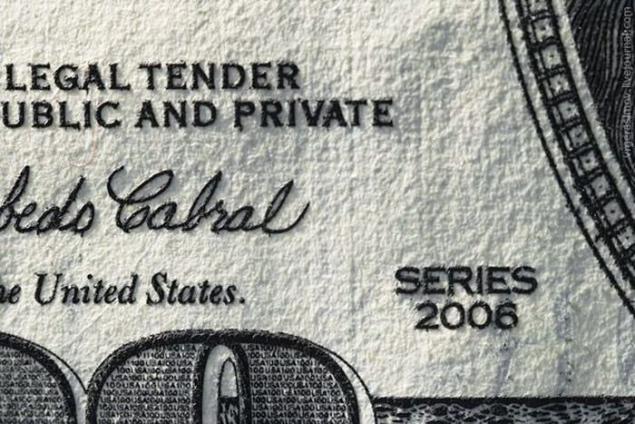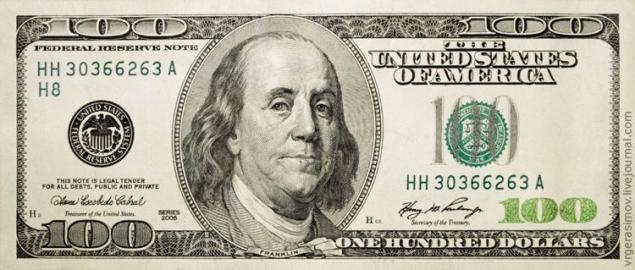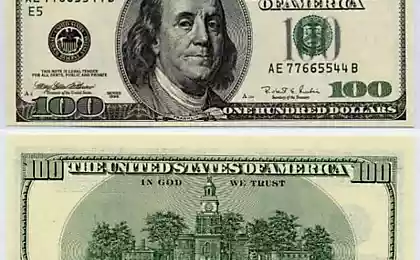1707
Close-hundred dollar bills (14 photos)
With Macro invite your
attention picture hundred dollar bills

A little history of the dollar: At the beginning of the XVI century in the mountains of north-west Bohemia began to operate the mine for the extraction of silver. In the valley close to the mine was founded by the city of St. Joachimsthal (the name of the valley, hoist - German "valley"). Beginning in 1519 there began to mint a silver coin with the image of St. Joachim of the Roman Empire. The coin was called "ioahimstaler." Over time, it became known Thaler. Thaler has received wide circulation in Europe. In Sweden, "Daler" minted from 1534 in Denmark - a 1544-th. In England it was called Dallaire, then Dallara and finally dollar. During the reign of Spain on the sea, one of the most solid currencies in the world was the Spanish silver and gold doubloons Reais. They were also called in dollars (in Portugal - Dalar). The Bank of England kept a great number of them, seized as war booty or received in payment of debts, the English King George III ordered the use of Spanish Reais in circulation. Every real cost 1/8 pound was called piece of eight (one-eighth, ounces), that eventually turned into a "peso» (peso). The peso hit the North American colonies, where, like other large silver coins were also dollar-denominated. With them is connected with the emergence of the famous sign $. A long piece of eight English on paper turned into a crossed-eight, which eventually became the $. The basic design of the majority of dollar bills was approved in 1928. On the obverse portraits of dollars ... no, not just the president, but other US government officials. In addition to the 2 presidents denominations portraits of the founding fathers: the first Treasury Secretary Alexander Hamilton's ten dollars and scientist, journalist, diplomat Benjamin Franklin on one hundred:

On the other side of the banknotes are placed images illustrating the history of the United States. $ 100 is Independence Hall, located in Philadelphia - the building where the Declaration of Independence was signed:

Among the remarkable, that is not visible to the naked eye, the first thing I found in this micro text USA100 characters denomination in the lower left corner:

Microtext THE UNITED STATES OF AMERICA tucked away on the lapel of his coat Franklin:

True the text is difficult to read, lost among other contrasting elements jacket

I should note that most of the elements have an increased thickness of the paint layer and well perceived by touch


The entire bill is dotted with colored fibers red and blue, which are clearly visible in the plain areas

All images and printing made very high quality and have clear elements of the pattern

Face in the lower right corner of the printed special shiny paint that changes color from green to black when you turn the bill

Remarkably executed portrait, clearly, and contrast, as if the substrate.

Curious is the reason why the dollar has become green. In 1869, the US Treasury Department has signed a contract with Philadelphia Messers J. & M. Cox for the production of paper money with special water marks a subtle vertical stripes 5-8 cm wide. Around the same years, the Treasury was first to print dollars Using green paint. The reason for innovation - the appearance of photos: banknotes old model made of black paint, which was applied only at the edges of the green color, it was very easy to reproduce photographically. As has already been used in the manufacture of green dye, it was used in large quantities, and the selection and purchase of new proved unnecessary. In recent years, dollar bills newly acquired new colors - shades of yellow and pink.


via Vladislav Gerasimov
attention picture hundred dollar bills

A little history of the dollar: At the beginning of the XVI century in the mountains of north-west Bohemia began to operate the mine for the extraction of silver. In the valley close to the mine was founded by the city of St. Joachimsthal (the name of the valley, hoist - German "valley"). Beginning in 1519 there began to mint a silver coin with the image of St. Joachim of the Roman Empire. The coin was called "ioahimstaler." Over time, it became known Thaler. Thaler has received wide circulation in Europe. In Sweden, "Daler" minted from 1534 in Denmark - a 1544-th. In England it was called Dallaire, then Dallara and finally dollar. During the reign of Spain on the sea, one of the most solid currencies in the world was the Spanish silver and gold doubloons Reais. They were also called in dollars (in Portugal - Dalar). The Bank of England kept a great number of them, seized as war booty or received in payment of debts, the English King George III ordered the use of Spanish Reais in circulation. Every real cost 1/8 pound was called piece of eight (one-eighth, ounces), that eventually turned into a "peso» (peso). The peso hit the North American colonies, where, like other large silver coins were also dollar-denominated. With them is connected with the emergence of the famous sign $. A long piece of eight English on paper turned into a crossed-eight, which eventually became the $. The basic design of the majority of dollar bills was approved in 1928. On the obverse portraits of dollars ... no, not just the president, but other US government officials. In addition to the 2 presidents denominations portraits of the founding fathers: the first Treasury Secretary Alexander Hamilton's ten dollars and scientist, journalist, diplomat Benjamin Franklin on one hundred:

On the other side of the banknotes are placed images illustrating the history of the United States. $ 100 is Independence Hall, located in Philadelphia - the building where the Declaration of Independence was signed:

Among the remarkable, that is not visible to the naked eye, the first thing I found in this micro text USA100 characters denomination in the lower left corner:

Microtext THE UNITED STATES OF AMERICA tucked away on the lapel of his coat Franklin:

True the text is difficult to read, lost among other contrasting elements jacket

I should note that most of the elements have an increased thickness of the paint layer and well perceived by touch


The entire bill is dotted with colored fibers red and blue, which are clearly visible in the plain areas

All images and printing made very high quality and have clear elements of the pattern

Face in the lower right corner of the printed special shiny paint that changes color from green to black when you turn the bill

Remarkably executed portrait, clearly, and contrast, as if the substrate.

Curious is the reason why the dollar has become green. In 1869, the US Treasury Department has signed a contract with Philadelphia Messers J. & M. Cox for the production of paper money with special water marks a subtle vertical stripes 5-8 cm wide. Around the same years, the Treasury was first to print dollars Using green paint. The reason for innovation - the appearance of photos: banknotes old model made of black paint, which was applied only at the edges of the green color, it was very easy to reproduce photographically. As has already been used in the manufacture of green dye, it was used in large quantities, and the selection and purchase of new proved unnecessary. In recent years, dollar bills newly acquired new colors - shades of yellow and pink.


via Vladislav Gerasimov























